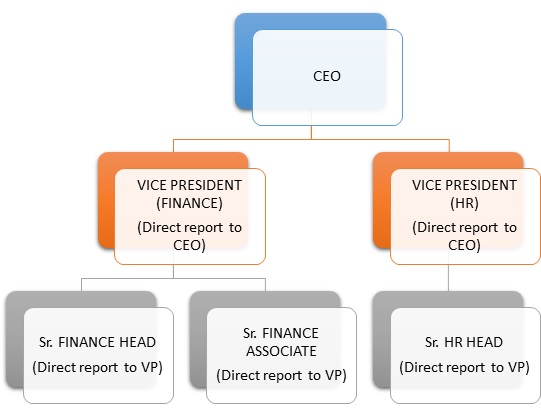- Business Concepts ›
- Human Resources (HR) ›
- Direct Report
Direct Report
Definition, Importance & Example
This article covers meaning & overview of Direct Report from HRM perspective.
What is meant by Direct Report?
Direct report is an employee or a worker who is an immediate subordinate to a senior person who is at his immediate position higher than his or her. A company can have many direct reports at many levels and of many types. Mostly this direct report concept is used in organizations that are very large in size, i.e. the number of employees is huge.
Direct reports not only mean people at very low positions or at clerical levels. A direct report can also be a vice president as he reports directly to CEO. Number of direct reports mainly depends on the type of organizational structure and its design. So meaning, organizations which are mechanistic in design. Flat structure organizations do not need many direct reports as the organizational hierarchy levels are not clearly defines and the organizations are organic in design. Direct reports are very helpful in an organization as they ease the flow of communication and help avoid disruptions in business path way.
Importance of Direct Report
Direct reports are very much essential in a business environment. Especially when the structure of an organization is large, the business demands are very different and large. Economies of scale and huge customer demand really rush up the need for proper understanding of procedures and hindrance free work environment. A direct report actually forms the link between the chains of levels in an organization and is an effective method of team management. A mechanistic designed organization follows a strict hierarchical type of organization. There is high level of centralization. Every decision has to be passed at every level before it reaches the top most authority who then takes the final decision. This highlights the role of direct reports.
Even at the level of CEO, His/her direct reports are the vice presidents of different departments which have many direct reports under them. If the communication or feedback whichever is to be passed is not addressed properly, business can be at a big loss and can adversely affect the decision making process. That’s why organizations need to have a very extensive learning and development process to pacify the process of communications and feedback in an organization and also to ensure that the role of direct reports is not taken for granted and is duly respected for the process of linkage they do.

Advantages & Disadvantages of Direct Report
Advantages of having direct reports in an organization structure are:
1. Easy communication.
2. Link between the hierarchies of levels.
3. Proper feedback system.
4. An aid to decision making process.
Certain disadvantages of direct report are:
1. Miscommunication may lead to adverse situations.
2. May lead to costly training and development processes.
Example of Direct Report
In any organization which is large in size, and is following a mechanistic design, presence of direct reports is a must. For e.g. in any big multinational company, supposedly specializing in IT sector. The hierarchical levels can be defines as – software engineers, team heads, project heads, Sr. software engineers, Vice presidents and CEO. Here the software engineers are the direct reports to their team heads under whom they work.
The team heads report directly the work of the engineers to the project heads, who then directly report the ongoing project details to the Sr. software engineers. Now the works are collated and passed on to the various vice presidents whom the sr. software engineers directly report to. Finally the vice presidents report directly about everything regarding the project to the CEO.
Hence, this concludes the definition of Direct Report along with its overview.
This article has been researched & authored by the Business Concepts Team which comprises of MBA students, management professionals, and industry experts. It has been reviewed & published by the MBA Skool Team. The content on MBA Skool has been created for educational & academic purpose only.
Browse the definition and meaning of more similar terms. The Management Dictionary covers over 1800 business concepts from 5 categories.
Continue Reading:
What is MBA Skool?About Us
MBA Skool is a Knowledge Resource for Management Students, Aspirants & Professionals.
Business Courses
Quizzes & Skills
Quizzes test your expertise in business and Skill tests evaluate your management traits
Related Content
All Business Sections
Write for Us